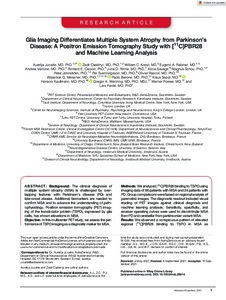Glia Imaging Differentiates Multiple System Atrophy from Parkinson's Disease: A Positron Emission Tomography Study with [C-11]PBR28 and Machine Learning Analysis
Rabiner Eugenii A.; Farde Lars; Poewe Werner; Cselényi Zsolt; Kaufmann Horacio; Kreisl William C.; Varrone Andrea; Seppi Klaus; Carson Richard E.; Rinne Juha O.; Wenning Gregor K.; Svenningsson Per; Rascol Olivier; Savage Alicia; Johnström Peter; Schou Magnus; Meissner Wassilios G.; Jucaite Aurelija; Barone Paolo
https://urn.fi/URN:NBN:fi-fe2021120158475
Tiivistelmä
Background The clinical diagnosis of multiple system atrophy (MSA) is challenged by overlapping features with Parkinson's disease (PD) and late-onset ataxias. Additional biomarkers are needed to confirm MSA and to advance the understanding of pathophysiology. Positron emission tomography (PET) imaging of the translocator protein (TSPO), expressed by glia cells, has shown elevations in MSA. Objective In this multicenter PET study, we assess the performance of TSPO imaging as a diagnostic marker for MSA.
Methods We analyzed [C-11]PBR28 binding to TSPO using imaging data of 66 patients with MSA and 24 patients with PD. Group comparisons were based on regional analysis of parametric images. The diagnostic readout included visual reading of PET images against clinical diagnosis and machine learning analyses. Sensitivity, specificity, and receiver operating curves were used to discriminate MSA from PD and cerebellar from parkinsonian variant MSA.
Results We observed a conspicuous pattern of elevated regional [C-11]PBR28 binding to TSPO in MSA as compared with PD, with "hotspots" in the lentiform nucleus and cerebellar white matter. Visual reading discriminated MSA from PD with 100% specificity and 83% sensitivity. The machine learning approach improved sensitivity to 96%. We identified MSA subtype-specific TSPO binding patterns.
Conclusions We found a pattern of significantly increased regional glial TSPO binding in patients with MSA. Intriguingly, our data are in line with severe neuroinflammation in MSA. Glia imaging may have potential to support clinical MSA diagnosis and patient stratification in clinical trials on novel drug therapies for an alpha-synucleinopathy that remains strikingly incurable.
Kokoelmat
- Rinnakkaistallenteet [19204]
